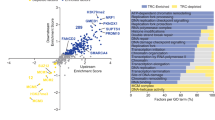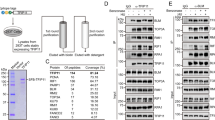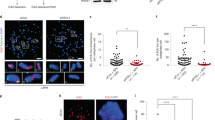Abstract
p53 has pleiotropic functions including control of genomic plasticity and integrity. Here we report that p53 can bind to several transcription factor IIH–associated factors, including transcription–repair factors, XPD (Rad3) and XPB, as well as CSB involved in strand–specific DNA repair, via its C–terminal domain. We also found that wild–type, but not Arg273His mutant p53 inhibits XPD (Rad3) and XPB DNA helicase activities. Moreover, repair of UV–induced dimers is slower in Li–Fraumeni syndrome cells (heterozygote p53 mutant) than in normal human cells. Our findings indicate that p53 may play a direct role in modulating nucleotide excision repair pathways.
This is a preview of subscription content, access via your institution
Access options
Subscribe to this journal
Receive 12 print issues and online access
$209.00 per year
only $17.42 per issue
Buy this article
- Purchase on Springer Link
- Instant access to full article PDF
Prices may be subject to local taxes which are calculated during checkout
Similar content being viewed by others
References
Cleaver, J.E. Defective repair replication of DNA in xeroderma pigmentosum. Nature 218, 652–656 (1968).
Satoh, M.S., Jones, C.J., Wood, R.D. & Lindahl, T. DNA excision-repair defect of xeroderma pigmentosum prevents removal of a class of oxygen free radical-induced base lesions. Proc. natn. Acad. Sci U.S.A. 90, 6335–6339 (1993).
Cleaver, J.E. & Kraemer, K.H. The Metabolic Basis of Inherited Disease 7th edn (McGraw-Hill, New York, 1994).
Malkin, D. et al. Germ line p53 mutations in a familial syndrome of breast cancer, sarcomas, and other neoplasms. Science 250, 1233–1238 (1990).
Donehower, L.A. et al. Mice deficient for p53 are developmentally normal but susceptible to spontaneous tumours. Nature 356, 215–221 (1992).
Livingstone, L.R. et al. Altered cell cycle arrest and gene amplification potential accompany loss of wild-type p53. Cell 70, 923–935 (1992).
Yin, Y., Tainsky, M.A., Bischoff, F.Z., Strong, L.C. & Wahl, G.M. Wild-type p53 restores cell cycle control and inhibits gene amplification in cells with mutant p53 alleles. Cell 70, 937–948 (1992).
Greenblatt, M.S., Bennett, W.P., Hollstein, M. & Harris, C.C. Mutations in the p53 tumour suppressor gene: clues to cancer etiology and molecular pathogenesis. Cancer Res. 54, 4855–4878 (1994).
Kastan, M.B. et al. A mammalian cell cycle checkpoint pathway utilizing p53 and GADD45 is defective in Ataxia - Telangiectasia. Cell 71, 587–597 (1992).
Lu, X. & Lane, D.P. Differential induction of transcriptionally active p53 following UV or ionizing radiation: defects in chromosome instability syndromes? Cell 75, 765–778 (1993).
EI-Deiry, W.S. et al. WAF1, a potential mediator of p53 tumour suppression. Cell 75, 817–825 (1993).
Zhan, Q. et al. The gadd and MyD genes define a novel set of mammalian genes encoding acidic proteins that synergistically suppress cell growth. Molec. cell Biol. 14, 2361–2371 (1994).
Okamoto, K. & Beach, D. Cyclin G is atranscriptional target of the p53 tumour suppressor protein. EMBO J 13, 4816–4822 (1994).
Waga, S., Hannon, G.J., Beach, D. & Stillman, B. The p21 inhibitor of cyclin-dependent kinases controls DNA replication by interaction with PCNA. Nature 369, 574–578 (1994).
Yonish-Rouach, E. et al. Wild-type p53 induces apoptosis of myeloid leukaemic cells that is inhibited by interleukin-6. Nature 352, 345–347 (1991).
Wang, X.W. et al. Hepatitis B virus X protein inhibits p53 sequence-specific DNA binding, transcriptional activity, and association with transcription factor ERCC3. Proc. natn.Acad.Sci U.S.A. 91, 2230–2234 (1994).
Schaeffer, L. et al. DNA repair helicase: a component of BTF2 (TFIIH) basic transcription factor. Science 260, 58–63 (1993).
Schaeffer, L. et al. The ERCC2/DNA repair protein is associated with the class II BTF2/TFIIH transcription factor. EMBO J. 13, 2388–2392 (1994).
Fischer, L. et al. Cloning of the 62-kilodalton component of basic transcription factor BTF2. Science 257, 1392–1395 (1992).
Humbert, S. et al. p44 and p34 subunits of the BFT2/TFIIH transcription factor have homologies with SSL1, a yeast protein involved in DNA repair. EMBO J. 13, 2393–2398 (1994).
Roy, R. et al. The DNA-dependent ATPase activity associated with the class II basic transcription factor BTF2/TFIIH. J biol. Chem 269, 9826–9832 (1994).
Goodrich, J.A. & Tjian, R. Transcription factors ME and IIH and ATP hydrolysis direct promoter clearance by RNA polymerase II. Cell 77, 145–156 (1994).
Drapkin, R. et al. Dual role of TFIIH in DNA excision repair and in transcription by RNA polymerase II. Nature 368, 769–772 (1994).
Weeda, G. et al. A presumed DNA helicase encoded by ERCC-3 is involved in the human repair disorders xeroderma pigmentosum and Cockayne's syndrome. Cell 62, 777–791 (1990).
Flejter, W.L., McDaniel, L.D., Johns, D., Friedberg, E.G. & Schultz, R.A. Correction of xeroderma pigmentosum complementation group D mutant cell phenotypes by chromosome and gene transfer: involvement of the human ERCC2 DNA repair gene. Proc. natn.Acad.Sci U.S.A. 89, 261–265 (1992).
Venema, J., Mullenders, L.H., Natarajan, A.T., Van Zeeland, A.A. & Mayne, L.V. The genetic defect in Cockayne syndrome is associated with a defect in repair of UV-induced DNA damage in transcriptionally active DNA. Proc. natn. Acad. Sci U.S.A. 87, 4707–4711 (1990).
Vermeulen, W., Stefanini, M., Giliani, S., Hoeijmakers, J.H. & Bootsma, D. Xeroderma pigmentosum complementation group H falls intoo complementation group D. Mutat. Res. 255, 201–208 (1991).
Troelstra, C. et al. ERCC6, a member of a subfamily of putative helicases, is involved in Cockayne's syndrome and preferential repair of active genes. Cell 71, 939–953 (1992).
Ma, L. et al. Mutational analysis of ERCC3, which is involved in DNA repair and transcription initiation: identification of domains essential for the DNA repair function. Molec. cell. Biol. 14, 4126–4134 (1994).
Bartek, J., Vojtësek, B. & Lane, D.P. Diversity of human p53 mutants revealed by complex formation to SV40 T antigen. Eur. J. Cancer. 29A, 101–107 (1992).
Huibregtse, J.M., Scheffner, M. & Howley, P.M. Cloning and expression of the cDNA for E6-AP, a protein that mediates the interaction of the human papillomavirus E6 oncoprotein with p53. Molec. Cell. Biol. 13, 775–784 (1993).
Xiao, H. et al. Binding of basal transcription factor TFIIH to the acidic activation domains of VP16 and p53. Molec. cell. Biol. 14, 7013–7024 (1994).
Seto, E. et al. Wild-type p53 binds to the TATA-binding protein and represses transcription. Proc. natn. Acad. Sci. U.S.A. 89, 12028–12032 (1992).
Thut, C.J., Chen, J.-L., Klemm, R. & Tjian, R. . p53 transcriptional activation mediated by coactivators TAFH40 and TAFH60. Science 267, 100–104 (1995).
Chou, P.Y., chou, P.Y & Fasman, G.D. Prediction of protein conformation. Biochemistry 13, 222–245 (1974).
Garnier, J., Osguthorpe, D.J. & Robson, B. Analysis of the accuracy and implications of simple methods for predicting the secondary structure of globular proteins. J. molec. Biol. 120, 97–120 (1978).
Braithwaite, A.W. et al. Mouse p53 inhibits SV40 origin — dependent DNA replication. Nature 329, 458–460 (1987).
Wang, E.H., Friedman, P.N. & Prives, C. The murine p53 protein blocks replication of SV40 DNA in vitro by inhibiting the initiation functions of SV40 large T antigen. Cell. 57, 379–392 (1989).
Oberosler, P., Hloch, P., Ramsperger, U. & Stahl, H. p53-catalyzed annealing of complementary single-stranded nucleic acids. EMBO J. 12, 2389–2396 (1993).
Bakalkin, G. et al. p53 binds single-stranded DNA ends and catalyzes DNA renaturation and strand transfer. Proc. natn. Acad. Sci. U.S.A. 91, 413–417 (1994).
Evans, M.K. et al. Gene-specific DNA repair in xeroderma pigmentosum complementation groups A, C, D, and F. Relation to cellular survival and clinical features. J. biol. Chem. 268, 4839–4847 (1993).
Dittmer, D. et al. Gain of function mutations in p53. Nature Genet. 4, 42–46 (1993).
Hodgman, T.C. A new superfamily of replicative proteins. Nature 333, 22–23 (1988).
Sakurai, T., Suzuki, M., Sawazaki, T., Ishii, S. & Yoshida, S. Anti-oncogene product p53 binds DNA helicase. Exp.Cell Res. 215, 57–62 (1994).
Hupp, T.R., Meek, D.W., Midgley, C.A. & Lane, D.P. Regulation of the specific DNA binding function of p53. Cell 71, 875–886 (1992).
Hupp, T.R. & Lane, D.P. Allosteric activation of latent p53 tetramers. Curr.Biol. 4, 865–875 (1995).
Kulesz-Martin, M.F., Lisafeld, B., Huang, H., Kisiel, N.D. & Lee, L. Endogenous p53 protein generated from wild-type alternatively spliced p53 RNA in mouse epidermal cells. Molec. cell. Biol. 14, 1698–1708 (1994).
Wu, L., Bayle, J.H., Elenbaas, B., Pavletich, N.P. & Levine, A.J. Alternatively spliced forms in the carboxy-terminal domain of the p53 protein regulate its ability to promote annealing of complementary single strands of nucleic acids. Molec. cell. Biol. 15, 497–504 (1995).
Stahl, H., Droge, P. & Knippers, R. DNA helicase activity of SV40 large tumour antigen. EMBO J. 5, 1939–1944 (1986).
Smith, M.L., Chen, I.T., Zhan, Q., O'Connor, P.M. & Fornace, A.J. Jr. Involvement of the p53 tumour suppressor in repair of UV-type DNA damage. Oncogene (In the press) (1995).
Li, L., Elledge, S.J., Peterson, C.A., Bales, E.S. & Legerski, R.J. Specific association between the human DNA repair proteins XPA and ERCC1. Proc.natn. Acad. Sci. U.S.A. 91, 5012–5016 (1994).
McWhir, J., Selfridge, J., Harrison, D.J., Squires, S. & Melton, D.W. Mice with DNA repair gene (ERCC-1) deficiency have elevated levels of p53, liver nuclear abnormalities and die before weaning. Nature Genet. 5, 217–224 (1993).
Wilcock, D. & Lane, D.P. Localization of p53, retinoblastoma and host replication proteins at sites of viral replication in herpes-infected cells. Nature 349, 429–431 (1991).
Dutta, A., Ruppert, J.M., Aster, J.C. & Winchester, E. Inhibition of DNA replication factor RPA by p53. Nature 365, 79–82 (1993).
Amundson, S.A., Xia, F., Wolfson, K. & Liber, H.L. Different cytoxic and mutagenic responses induced by X-rays in two human lymphoblastoid cell lines derived from a single donor. Mut. Res. 286, 233–241 (1993).
Little, J.B., Nagasawa, H., Keng, P.C., Yu, Y. & Li, C.-Y. Absence of radiation-induced G1 arrest in two closely related human lymphoblast cell lines that differ in p53 status. J. biol. Chem. 270, 1–5 (1995).
Kawashima, K., Mihara, K., Usuki, H., Shimizu, N. & Namba, M. Transfected mutant p53 gene increases X-ray-induced cell killing and mutation in human fibroblasts immortalized with 4-nitroquinoline 1-oxide but does not induce neoplastic transformation of the cells. Int. J. Cancer 61, 76–79 (1995).
Ruppert, J.M. & Stillman, B. Analysis of a protein-binding domain of p53. Molec. cell. Biol. 13, 3811–3820 (1993).
Naegeli, H., Bardwell, L. & Friedberg, E.G. The DNA helicase and adenosine triphosphatase activities of yeast Rad3 protein are inhibited by DNA damage. A potential mechanism for damage-specific recognition. J. biol.Chem 267, 392–398 (1992).
Srivastava, S., Zou, Z.Q., Pirollo, K., Blattner, W. & Chang, E.H. Germ-line transmission of a mutated p53 gene in a cancer-prone family with Li-Fraumeni syndrome. Nature 348, 747–749 (1990).
Bohr, V.A. & Okumoto, D.S. Analysis of DNA repair in defined genomic sequences. DNA Repair, A Manual of Research Procedures. (eds Hanawalt, P.C. & Friedberg, E.G.) 347–366 (Marcel Dekker, New York, 1988).
Author information
Authors and Affiliations
Rights and permissions
About this article
Cite this article
Wang, X., Yeh, H., Schaeffer, L. et al. p53 modulation of TFIIH–associated nucleotide excision repair activity. Nat Genet 10, 188–195 (1995). https://doi.org/10.1038/ng0695-188
Received:
Accepted:
Issue Date:
DOI: https://doi.org/10.1038/ng0695-188
This article is cited by
-
Structure of the p53/RNA polymerase II assembly
Communications Biology (2021)
-
DNA repair pathways and their roles in drug resistance for lung adenocarcinoma
Molecular Biology Reports (2021)
-
Structural Insight into the Mechanism of Dibenzo[a,l]pyrene and Benzo[a]pyrene-Mediated Cell Proliferation Using Molecular Docking Simulations
Interdisciplinary Sciences: Computational Life Sciences (2018)
-
The role of DNA damage responses in p53 biology
Archives of Toxicology (2015)
-
Nucleotide excision repair/transcription gene defects in the fetus and impaired TFIIH-mediated function in transcription in placenta leading to preeclampsia
BMC Genomics (2014)



